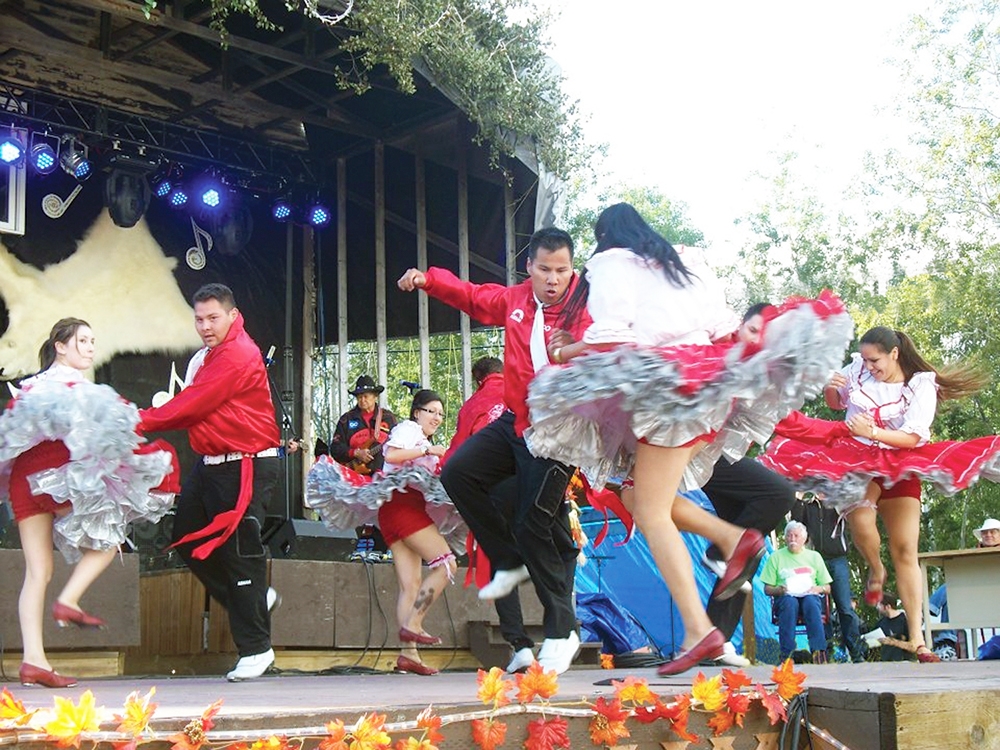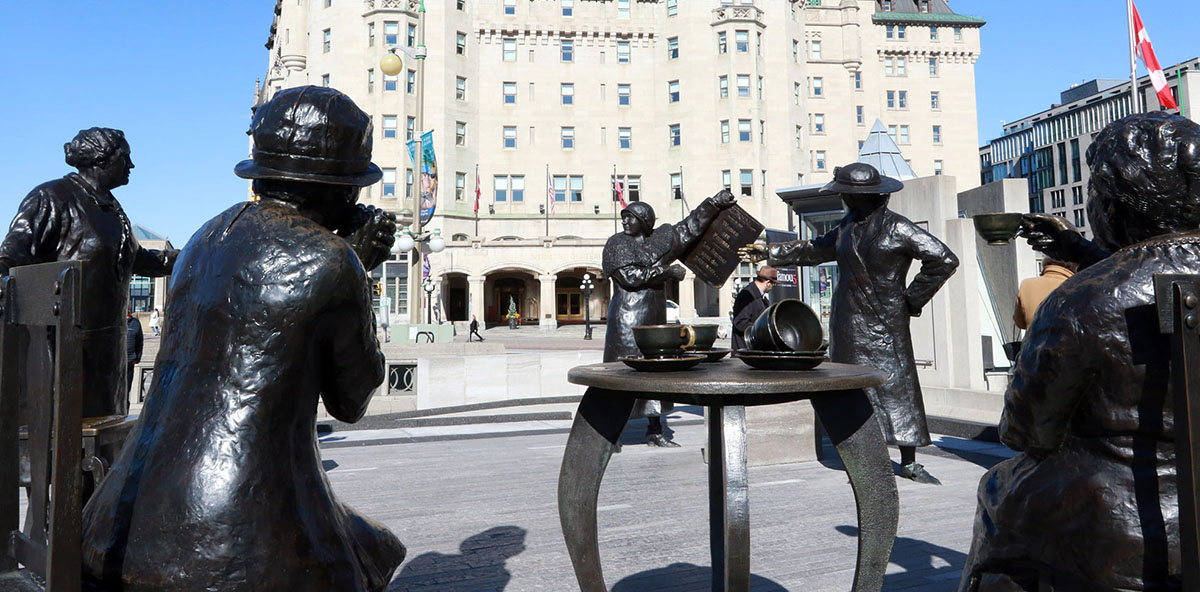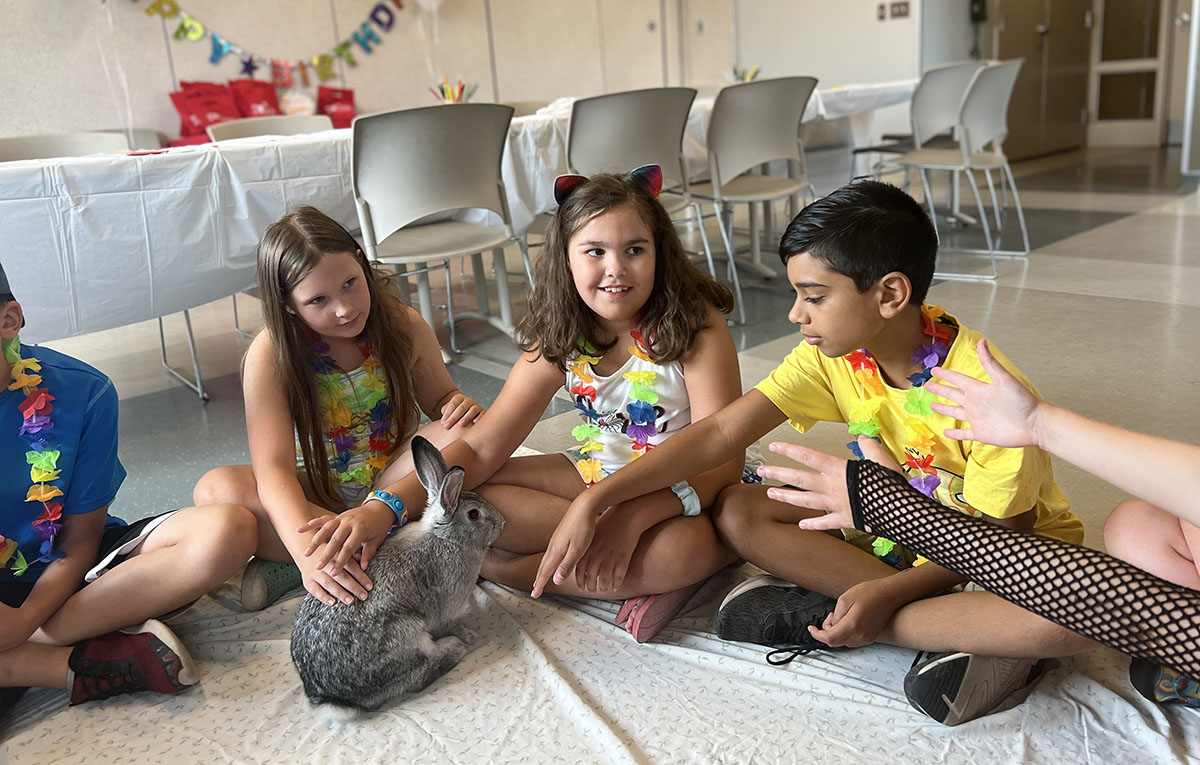
Celebrating the Cultural Fusion of the Métis
Featured Image: Internationally-acclaimed troupe, the Asham Stompers promote the richness of Métis culture through dance.
Métis arts, language and symbols are expressions of a unique cultural fusion. The people of the Métis Nation are distinct from other Aboriginal peoples. Their culture and traditions come from the combination of Aboriginal peoples and Europeans who travelled and settled widely in the north and west.
Métis artists and musicians are making a mark for themselves in Canadian arts communities. This blended heritage of ancient North American peoples’ traditional arts, French voyageur customs from centuries ago, and modern media and styles can be seen and heard in many places. Far from being considered a folk art of interest only to those of the same heritage, Métis art and music peppers Canada’s cultural landscape.
Perhaps the most widely recognized symbol of Métis heritage is the Métis sash. Sashes evolved from the bright scarves of French Canadians which Voyageurs brought to western Canada. The finger-weaving technique used to make the sash came from Eastern Woodland peoples’ traditions. They had woven plant fibres for tumplines, clothing, and other household articles. Europeans introduced wool as a fiber and a sash worn as a garment to the Six Nations Confederacy, Potawatomi and other nearby nations of the Woodland peoples, and that combination of ideas resulted in the distinctive sash.
The sash served as a way to carry items, as a towel and washcloth, as a saddle blanket, rope, or bridle, was worn ornamentally, and also hinted at the joie-de-vivre which continues to be a prominent aspect of Métis culture. This display of tradition has influenced many histories and artistic works by non-Métis as well, including famed American artist and sculptor Frederic Remington whose paintings faithfully documented the lives of peoples in Canada and the western USA in the late 1800s.
By the late 20th century it had become a proud symbol of Métis identity.
Purely traditional art forms are a thriving aspect of Métis arts. Beadwork and embroidery are practiced today, still using the styles, colours and often materials of the past. Some of this historically accurate work is created by Jennine Krauchi and her mother Jenny Meyer. Their knowledge and expertise are admired around the world, and their products incorporate techniques passed down for generations. Krauchi works extensively with museums, creating both historical reproductions and new works in the old style, but with her own designs. She also does commissioned work in which she portrays her clients’ stories.
The patterns are a mélange of ancient French embroidery patterns combined with Indigenous images and stories from nature. “The Sioux called the Métis the Flower Beadwork People,” says Krauche. “For me this is not a hobby. It’s a very important part of my life.” Making a living in the arts is an accomplishment in itself, and even when her works command high prices she says the selling price doesn’t really reflect all the time spent on research, sourcing materials and doing the intricate work. One of her clients has been the Hudson’s Bay Company, for whom she made Christmas stockings out of HBC blanket pieces decorated with traditional Métis beading, trimmed with deerskin, fur and woollen pompoms. It was an intensive project but a rewarding one, that also tied in with her museum experience. “Years ago the Bay donated their collection to the Manitoba Museum in Winnipeg. I did replica work on that exhibit and was able to look at the original pieces, and many years later I was given this great opportunity.”
She finished a significant and large project, currently on display in the new Human Rights Museum. The Octopus bag (45 inches wide by 23 feet high) symbolizes the Road Allowance People who were forced out of their homes by the government in the late 1800s. She also goes to schools and teaches children about the craft and the history that goes with it.
The Métis culture also has vibrant music and language. The Michif language is different than other language fusions in that, rather than being a patois like Créole in Louisiana, the oral language uses French grammar and nouns, and most other words are Cree.
One of the champions of the language is Norman Fleury. He teaches Michif at the University of Brandon in Manitoba, is a frequent guest lecturer at other universities and is the translator or author of several books. Michif has been codified as a written language for about 20 years. Yet it is a language formed many generations ago. Fleury says his mother, who lived to be 108, spoke it, her parents (born in 1887 and 1880) spoke it, and their parents spoke it.
The Gabriel Dumont Institute in Saskatoon carries many of his books and has strong collaborations with other Michif specialists. The Institute promotes the use of the language and provides resources for students from kindergarten to Grade 12. Its plans include devoting additional resources to preserving Michif.
Tradition is also evident in the fiddle music associated with Métis culture. The foot-stomping, rollicking joy of the music, and the fast step dancing that accompanies it, are instantly recognizable. Songs such as the famous Red River Jig (oayache mannin in Michif) have been played at concerts, dances and parties across the country for generations. The high-energy steps and intricate patterns have elements of Cree, Ojibwe, Highland Scots, French, Acadian, Irish, and Scandinavian dance styles.
Dance competitions are often part of dance festivals which include other traditional dances such as square dancing, Ottawa Valley step dancing, or round dancing. Some of the best dancers are the Asham Stompers, founded by Arnold Asham. He felt it was important to help preserve and celebrate the music he’d grown up with as a child near Reedy Creek in Manitoba. Asham also thinks promoting jigging brings the richness of Métis traditions to people in a fun way.
The group has performed at the 2010 Olympics in Vancouver, in concert halls across the country, and in music festivals in Mexico and Europe. Many members have won world dance championships. “I fundamentally believe that dance is going to bring us all together,” says Asham. “Louis Riel said, ‘Our people will sleep for a hundred years, and when they arise it will be their arts and their culture that will bring their spirit back,’ and that is exactly what is happening today with the pow-wows and the dance.”
In the fields of painting and design, successful Métis artist Christi Belcourt stands out. One of her designs, executed in stained glass by Vision Art Glass Studio, was unanimously chosen by a selection committee to commemorate the legacy of residential schools and the historic apology from the Government of Canada in 2008. The design was unveiled early in 2012 and the window, titled Giniigaaniimenaaning (Looking Ahead), is installed in the Centre Block on Parliament Hill.
Belcourt has received other recognition, including the Ontario Arts Council Aboriginal Arts Award, which included a prize of $10,000. Her artwork hangs in the Museum of History, the National Gallery of Canada, the Nature Conservancy of Canada, the Art Gallery of Ontario, and many other institutions and galleries.
The largest collection of her work can be seen in the Gabriel Dumont Institute. Her paintings incorporate designs from nature reflective of traditional beadwork, which Belcourt says she was exposed to since childhood. Her interests include medicinal plants. In fact, she authored and illustrated a book about them.
She is also leading the Walking with Our Sisters project, an installation of 1700 pairs of moccasins made by people of all ages and cultural backgrounds, which honours murdered and missing indigenous women. The show will visit 32 North American locations in 2020.
Métis artists greatly contribute to the social and cultural fabric of Canada and will no doubt continue to do so in the generations to come.









